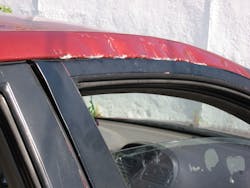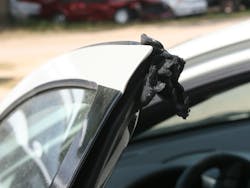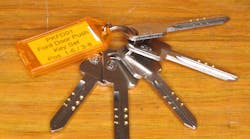The average age of vehicles on the streets in North America is 12.2 years, according to S&P Global Mobility. Over the past year, this figure went up by two months — no doubt because of the increase in the prices of gasoline and used vehicles. The fact is that almost every vehicle we unlock these days was made after 2006, so there’s no point in discussing ancient history with respect to vehicle-entry methods. Instead, I’ll stick with discussing post-2006 vehicles.
Why 2006, and not 2010, which is 12 years ago and the average age of vehicles on the road? Because the original side-impact and rollover standards for vehicles went into effect for the 2006 model-year.
Manufacturers had years to prepare for the 2006 deadline, and many vehicles from the early 2000s were compliant with the 2006 standards. These standards changed the way that locksmiths gain entry to locked vehicles. Since 2006, the side-impact and rollover standards have been amended and extended in many ways. The bottom line, from a locksmith’s point of view, is that poking around inside car doors with wire tools or antiquated slim jims is a waste of time at best and dangerous at worst.
As a result of the side-impact and rollover standards, there are almost no “linkage rods” inside vehicle doors. Linkage rods have been replaced primarily by bicycle-style cables and, in some cases, by electronic systems. Attacking either system by using a metal tool that goes inside the door is pointless and easily can disconnect cables or short out wiring, which makes the job more difficult and often requires costly repairs.
The Two Methods
I always have taught that there are three reasonable methods for unlocking vehicles: pick the lock, attack the lock operator inside the vehicle or attack the mechanism inside the door. Because the side-impact and rollover standards essentially eliminated the possibility of inside-the-door attacks, that now leaves only two methods: attacking the inside lock operator and picking the lock.
Please understand that in automotive locksmithing, there are exceptions to every rule. I fully understand that on some vehicles, there still are ways to attack the mechanism inside the door, but I’ve found those exceptions to be few and far between. One that comes to mind is certain Volvo “big rigs” that use side-milled locks and can be unlocked best by attacking the power-door lock mechanism inside the door.
Regardless of the tool and the manufacturer, most of them work the same way: You open a gap between the door and the body of the vehicle and then use a long tool, typically a metal rod, to operate the inside lock control just as though you were inside the vehicle.
The biggest problem with long-reach tools is opening the gap between the door and the frame without damaging the vehicle. Judging by some of the tools that are on the market and some of the damage I’ve seen on vehicles, a lot of people don’t seem to care about the damage.
It not only is possible but even easy to use a long-reach tool without causing any damage. Over the years, I’ve demonstrated the original Jiffy-Jak cleanly thousands of times. The important thing is to approach the entire operation carefully and to not be in a hurry.
Using an air wedge to open the gap also is a big factor in preventing damage, yet one of the best-selling tools on the market comes with what essentially is a chainsaw wedge that you’re supposed to jam between the door and the frame, which often shreds weatherstripping along the way. So, my desire to avoid damaging a customer’s car apparently is far from universal.
Pickin’ & Grinnin’
Several years ago, I dislocated my right shoulder severely and tore my rotator cuff (worst pain that I ever endured). As a result, holding my arm up to manipulate a long-reach tool became painful.
This gave me big incentive to sharpen my lock-picking skills! Today, thanks to Original Lishi 2-in-1 tools, I rarely use a long-reach tool. Using the Lishi tools for vehicle opening apparently surprises a lot of locksmiths as well as my customers. I can’t tell you how many times I’ve been told, “I’ve never seen it done like that before!” or “Why didn’t the last guy use a tool like that?”
Afterward, she showed me the damage on the passenger side of the truck from the “last guy” and asked why everyone didn’t use a tool like mine! After looking at the impressive damage, I just shook my head and said I had no idea why people did that sort of thing.
Of course, using the Lishi tools or any other picking method requires a significant investment in time and equipment. Although the price of the tools has dropped considerably since they were introduced, they still aren’t inexpensive — although there are a LOT of cheap knockoffs that rarely work and break easily!
I still am not a member of the National Automotive Service Task Force (NASTF), so when I generate a key for a vehicle, I almost always use a Lishi 2-in-1 tool to decode the lock. The trick to getting comfortable with using a Lishi tool for vehicle entry is simply to use them a LOT. When I got my first Lishi tool, I sat at the workbench and practiced using the tool for hours. Sometimes, such as when I was learning to pick the HU-100 and HU-101 keyway locks, I practiced using the tool on a lock that had a slot, so I could see what was happening while I was practicing. But mostly I either used new locks that I bought just for the purpose of practice or used locks that I scavenged from my local U-Pull-It.
Practice really is the secret. A friend of mine has had several Lishi tools for a long time but hasn’t mastered the use of them. Yet he routinely manipulates safe locks. I’ve tried to make the point that if he practiced using the Lishi tools for even a fraction of the time he spent learning safe manipulation, he soon would become an expert with the Lishi tools. But in his case, he would rather just refer the automotive work to me, which I don’t mind in the slightest.
Steve Young has been a locksmith since 1973 and has trained and taught locksmiths since 1988. He is a frequent contributor to Locksmith Ledger.








